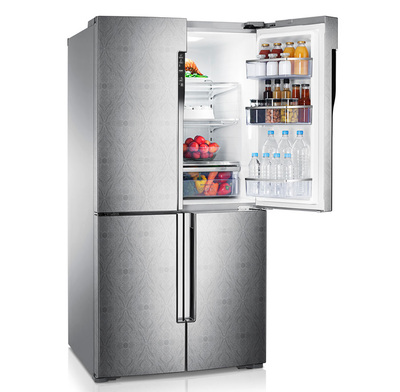If you have a refrigerator-freezer combo, you may expect both compartments to work properly and keep your food fresh and frozen. However, sometimes you may encounter a puzzling situation where the freezer works but not the fridge.
Why does this happen? And more importantly, how can you fix it?
In this post, we’ll explore some of the possible causes and solutions for this common problem. We’ll also give you some tips on how to prevent it from happening again.
The short answer is that your freezer works but not the fridge because something is preventing the cold air from reaching the fridge compartment. This could be due to a dirty or faulty component, such as the evaporator fan, the damper control, or the thermistor. It could also be due to poor organization, overstuffing, or frost buildup in your fridge.
How Does a Refrigerator-Freezer Combo Work?
To understand why your freezer works but not the fridge, you need to know how a refrigerator-freezer combo works.
A refrigerator-freezer combo is a type of appliance that has two separate compartments: one for refrigerating food and one for freezing food. The two compartments have different temperature settings, usually around 37°F (3°C) for the fridge and 0°F (-18°C) for the freezer.
However, both compartments share the same cooling system, which consists of several components, such as:
- Compressor: The compressor is a pump that compresses refrigerant gas and circulates it through the cooling system.
- Condenser coils: The condenser coils are tubes that release heat from the refrigerant gas to the outside air.
- Evaporator coils: The evaporator coils are tubes that absorb heat from the inside air and turn the refrigerant gas into liquid.
- Evaporator fan: The evaporator fan is a motor that blows cold air over the evaporator coils and into the freezer compartment.
- Damper control: The damper control is a valve that opens and closes to regulate the amount of cold air that flows from the freezer to the fridge compartment.
- Thermistor: The thermistor is a sensor that monitors the temperature inside the fridge and sends signals to the control board.
The cooling system works by creating a cycle of heat exchange between the refrigerant and the air. The compressor compresses the refrigerant gas and sends it to the condenser coils, where it releases heat and turns into liquid. The liquid refrigerant then flows to the evaporator coils, where it absorbs heat and turns back into gas. The evaporator fan blows cold air over the evaporator coils and into the freezer compartment, where it cools down your food. Some of this cold air then passes through the damper control and into the fridge compartment, where it cools down your food as well. The thermistor measures the temperature inside the fridge and sends signals to the control board, which adjusts the damper control accordingly.

What Causes Your Freezer to Work but Not Your Fridge?
As you can see, your freezer works but not your fridge because something is preventing the cold air from reaching the fridge compartment. This could be due to several reasons, such as:
- Dirty condenser coils: If your condenser coils are dirty or dusty, they may not be able to release heat efficiently. This can cause your compressor to overheat and shut down, or your refrigerant to lose pressure and become less effective. As a result, your cooling system may not be able to produce enough cold air for both compartments.
- Faulty evaporator fan: If your evaporator fan is faulty or broken, it may not be able to blow cold air over the evaporator coils and into the freezer compartment. This can cause your evaporator coils to freeze up and block the airflow. As a result, your freezer may still work but not your fridge.
- Faulty damper control: If your damper control is faulty or broken, it may not be able to open and close properly. This can cause your freezer to get too much or too little cold air, or your fridge to get none at all. As a result, your freezer may still work but not your fridge.
- Faulty thermistor: If your thermistor is faulty or broken, it may not be able to measure the temperature inside your fridge accurately. This can cause your control board to send wrong signals to your damper control. As a result, your freezer may still work but not your fridge.
- Poor organization: If you organize your food poorly in your fridge or freezer, you may block or restrict the airflow inside. This can prevent cold air from reaching all parts of your fridge or freezer evenly. As a result, some areas may be colder or warmer than others.
- Overstuffing: If you overstuff your fridge or freezer with too much food, you may reduce the space and airflow inside. This can prevent cold air from circulating properly and reaching all parts of your fridge or freezer evenly. As a result, some areas may be colder or warmer than others.
- Frost buildup: If you have frost buildup in your freezer or fridge, you may have a problem with your defrost system. The defrost system is a mechanism that periodically melts the frost on your evaporator coils to prevent them from freezing up. If your defrost system is faulty or broken, it may not be able to melt the frost effectively. This can cause your evaporator coils to freeze up and block the airflow. As a result, your freezer may still work but not your fridge.

How to Fix Your Freezer That Works but Not Your Fridge?
Depending on the cause of your problem, you may be able to fix your freezer that works but not your fridge by yourself or with professional help. Here are some possible solutions for each cause:
- Dirty condenser coils: You can clean your condenser coils by unplugging your appliance, removing the back panel, and using a vacuum cleaner or a soft brush to remove the dust and dirt. You should do this at least once a year or more often if you have pets or live in a dusty area.
- Faulty evaporator fan: You can replace your evaporator fan by unplugging your appliance, removing the back panel, and locating the fan near the evaporator coils. You should then disconnect the wires and screws that hold the fan in place and install a new one with the correct replacement part for your model. You should also check the fan blades for any damage or obstruction and clean them if necessary.
- Faulty damper control: You can replace your damper control by unplugging your appliance, removing the back panel, and locating the damper near the top of the fridge compartment. You should then disconnect the wires and screws that hold the damper in place and install a new one with the correct replacement part for your model. You should also check the damper for any damage or obstruction and clean it if necessary.
- Faulty thermistor: You can replace your thermistor by unplugging your appliance, removing the back panel, and locating the thermistor near the evaporator coils. You should then disconnect the wires and clips that hold the thermistor in place and install a new one with the correct replacement part for your model. You should also check the thermistor for any damage or corrosion and clean it if necessary.
- Poor organization: You can improve your organization by arranging your food in a way that allows enough space and airflow inside your fridge or freezer. You should also avoid placing large or tall items near the vents or fans that distribute cold air. You should also check the vents or fans for any dust, food, or frost that can block the airflow and clean them if necessary.
- Overstuffing: You can avoid overstuffing by removing any excess or expired food from your fridge or freezer. You should also avoid filling your fridge or freezer more than 75% of its capacity. You should also check the door seals for any damage or gaps that can let warm air in and cold air out and replace them if necessary.
- Frost buildup: You can defrost your freezer or fridge by unplugging your appliance, removing all food items, and placing towels or pans to catch any water. You should then let the frost melt naturally or use a hairdryer to speed up the process. You should also check the defrost heater, defrost thermostat, and defrost timer for any damage or malfunction and replace them if necessary.
How to Prevent Your Freezer from Working but Not Your Fridge?
To prevent your freezer from working but not your fridge, you should follow these tips:
- Perform regular maintenance on your appliance, such as cleaning the condenser coils, checking the door seals, and replacing any faulty components.
- Monitor the temperature settings of your fridge and freezer and adjust them according to your needs and preferences.
- Organize your food properly in your fridge and freezer and avoid overstuffing them with too much food.
- Defrost your freezer or fridge regularly or whenever you notice frost buildup on the evaporator coils.

Conclusion
Your freezer works but not your fridge because something is preventing the cold air from reaching the fridge compartment. This could be due to a dirty or faulty component, such as the evaporator fan, the damper control, or the thermistor. It could also be due to poor organization, overstuffing, or frost buildup in your fridge.
You can fix this problem by cleaning or replacing any faulty components, improving your organization, avoiding overstuffing, or defrosting your freezer or fridge.
You can prevent this problem by performing regular maintenance on your appliance, monitoring the temperature settings of your fridge and freezer, organizing your food properly in your fridge and freezer, and defrosting your freezer or fridge regularly.




